NOTE: I wrote this article in 2003. I've learned a few things in the intervening
time, but I'm leaving the article mostly as-written for the time being. Most
of the information here is correct, although a few things I choose to do differently
now.
Serving the Tiny Masters:
- adventures in home sericulture -
I open the door, and I can hear them. The sound is only a
soft, quiet pattering, like rain on the roof ... but I know what they're thinking.
"Feed us. You must feed us. Bring the food here to us, now." They
wave back and forth hypnotically, like tiny cobras - I have to obey.
One month each spring for three years now, the Tiny Masters
have ruled my life. I wake early and stumble bleary-eyed out into the yard to
fetch their food. I change their trays every other day, adjust the temperature
and humidity in their room so that they will be content, fuss over them and
attend to their needs. The main need is food. Every day, three times a day.
For the fourth and final week, four times a day. They are always hungry, the
Tiny Masters.
I got started raising silkworms in 2001. A friend of mine said
that she had raised them in school as a child, and they were an easy and fun
project. I have been weaving for over a decade now, as well as using silk in
my soap, and the vision of home-made silk for special projects was very seductive.
I started looking into the requirements, and found them to be very simple, although
quite firm - a clean, toxin-free environment, a ready supply of fresh mulberry
leaves, warm room temperature (78' to 88'F for fastest growth) and time. A lot
of time.
Silkworms are caterpillars. They are the larval stage of the
white silkmoth, Bombyx mori. They are the world's only truly domesticated
insect, having been bred and selected for thousands of years, mainly for quality
of silk (color, strength, volume) but also for ease of rearing. The end product
is a very efficient leaves-into-silk machine; after four weeks of voracious
eating, each worm will spin a cocoon that looks like a Styrofoam "peanut"
composed of up to a mile of unbroken silk fiber. The worms in their current
state could never survive in the wild, since they have no chemical or physical
defenses to protect them from predators. The larvae (the worms) are white and
soft-bodied (no camouflage or spines) and the imagos (adults) are fat-bodied
and totally flightless. There is another semi-domesticated type of silkworm
that produces "Tussah" silk; these feed on oak leaves, and have a
very different lifestyle than the classic bombyx silkworm. They're somewhat
less receptive to hand-rearing at home, but eggs are occasionally available
if you're feeling really adventurous.
I order silkworm eggs in the spring. I get mine from Mulberry
Farms mainly because they're less expensive. I have tried to over-winter the
eggs in cold storage, but have not yet hit upon the correct balance of temperature,
humidity, and timing. Hopefully, I've gotten this sorted out, and starting this
year I'll be able to rear from eggs I stored from last year's moths. The eggs
are the size of a ball-point pen's ball, and if you order them, come attached
to the bottom of a petrii dish or a piece of paper. If you have eggs from your
own moths, they're likely to be on whatever substrate you have for them to lay
on (I use freezer paper) and laid out in a round-ish pattern that the moth seems
to prefer.
The eggs hatch usually within a week of arrival. They need about
two weeks from the time they're removed from cold storage, to the time they
hatch, but most of the mail order houses send them about halfway through that
time. Upon hatching, the larva are tiny - about the size of a typewriter dash.
They are called "kego" by the Japanese, which means "hairy baby".
The Indians call them "chawki" silkworms. They are also called "Ant
Silkworms," because they really do look like small brown ants. They typically
all hatch on the same day, and usually at dawn, even if they don't see the sun.
Don't ask me how they know, but they seem to. There are always a few early risers
the day before, and a few per day for a couple of days after.
The tiny kegos have to eat within four hours of hatching, or
they die of dehydration. For the first couple of days, they require only the
tenderest tip leaves of the branch. Some folks say that you need to chop the
leaves up; I find that tearing them in half is sufficient, because they seem
to just start chewing wherever they feel like. These leaves need replacing about
three times a day, mainly because they are tender and dry out easily. The worms
receive all their fluids from the leaves they eat. The leaves must be fresh
and clean and unwilted, but not damp. If the leaves are wet, the worms drown.
I usually keep the worms in a tray with a lid to slow the drying of the leaves,
but if you take this route, be vigilant about mold. If the leaves mold, and
the worms eat the mold, they die. The worms expect to be fed; that's why I call
them the Tiny Masters. When you open the lid of their container, they wave their
heads around, reaching for the leaves they know will be immediately forthcoming.
The leaves have to be placed right on top of the worms; if you place a worm
six inches from a juicy leaf, it will die. They won't let go of a leaf except
to crawl to another leaf, which is a great advantage in hand-rearing - they
don't crawl out of a tray or dish.
Silkworms grow very fast. They will increase their body size
by 10,000 times within their one-month larval life. Within four days, they will
shed their skins, and graduate to the second instar. Instars are the stages
of larval development; there are 5 of them between hatch and cocoon, each one
accompanied by a new skin and a growth spurt. The process of shifting skins
is called ecdysis; this is a characteristic of all insects, as their
exoskeletons are only slightly flexible, and don't allow for much growth. The
second instar larvae are gray and smooth, where the first instar was dark brown
and hairy. Each instar has a significantly larger head, and you can easily tell
the new second-instar worms from the first-instar worms by the size of their
faces. Later stages are closer and closer to pure white. After the first two
instars, which each last for four to five days, each successive instar lasts
about a week. Each time the larvae are getting ready to shed their skins, they
will spend several hours not eating, sitting immobile with their heads upward.
Afterwards, you find the shrugged-off skins on the bottom of the tray or attached
to a leaf, looking like where a lazy husband stepped out of his pants.
The bigger they get, the more they eat. In the fifth instar,
the larvae will begin to change their metabolism; they go from primarily increasing
their own body mass, to primarily forming silk proteins. Their thorax area gets
larger and larger, and they eat nonstop, night and day. After this week of gorging
themselves, the worms will begin to wave their heads about as if praying ecstatically.
This means that they are feeling the need to cocoon. They start to sketch silk
onto anything around them, and climb upward. It is the only time in their life
cycle that the worms will crawl out of their tray if allowed.
The best cocooning arrangements allow the worms to have individual
compartments. This maximizes silk output by allowing each worm to make a perfect
cocoon. Egg cartons work, as do small sections of paper towel tubing. I have
also, when faced with the sudden cocooning of about a thousand worms at once,
made little artificial bushes using wire and the branches from the mulberry
tree. They climb up it, find a likely spot, and start making little silk hammocks.
This silk is called "flossing." It is tough and not always one continuous
strand. After they have their hammocks well built, the worms begin the serious
cocooning. The perfect cocoon is a long oval with a "waist" in the
middle, and has a wrinkled surface. Some strains of silkworm will spin pure
white, others spin a golden yellow. There are some rare strains that spin cocoons
of other shades, but these are not readily available. The silk fiber is actually
made of two smaller strands called "baves." Silk consists of two proteins
- fibroin and sericin. The fibroin makes the long strand of the silk, and the
sericin binds the strands together in the cocoon. Cocoons which have been "degummed"
have been simmered in a bath of chemicals (see "making mawatas") to
remove the sericin. Most silk is processed with the gum on it, since it protects
the delicate fiber, and then the sericin is removed after spinning or weaving.
Silk used for soapmaking is typically already degummed.
In commercial silk production, most cocoons are stifled. This
means that they are treated with heat or steam to kill the pupa inside. If the
moth hatches out, then the cocoon cannot be reeled off; reeling produces the
finest silk. Cocoons which have hatched out (ecloded) are still useful for spinning
silk, and can be made into hankies or caps. These are ways of stretching out
the fibers to make spinning from them easier. If the cocoon is not stifled,
then in about two weeks the moth will secrete a brown goo, which softens the
sericin gum, and push its way out of the cocoon. The adults, also called imagos,
are squat-bodied, covered in soft fuzz, and totally unable to fly. The males
can detect the scent of the females from hundreds of feet away, using special
receptors in their comb-like antennae. They mate for a few hours, and then the
female will lay between 200 and 500 tiny eggs. The adults are not equipped with
working mouth parts, and since they cannot eat, they die soon after mating.
Their entire life cycle, from eggs to eggs, takes about six to eight weeks.
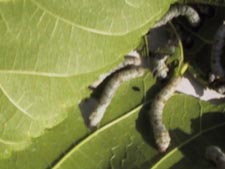 |
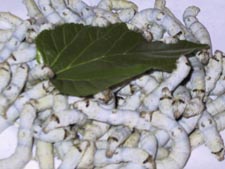 |
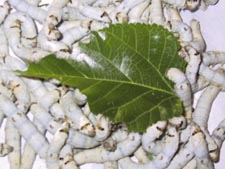 |
|
These worms are in their third instar.
They're still relatively small
|
This is a bunch of fifth-instar worms,
about 3.5 weeks old. I've just cleaned their tray, and given them a fresh
leaf.
|
Within minutes, they'll reduce it to
mere veins.
|
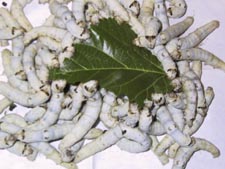 |
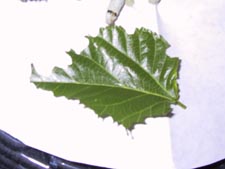 |
|
|
Kind of like...
|
vegetarian piranha.
|
|

